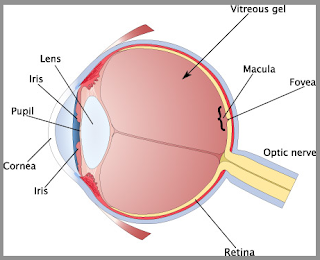How the Eye Works – The Basics

The human eye is truly amazing. Although they have a relatively short list of components, the eyes combine to work together essentially as a 3D video camera.
- Cornea: This is the “windshield” of the eye. It is also the most powerful of the two lenses the eye possesses.
- Iris & Pupil: The iris is the colored (smooth muscle) part of the eye. It forms the pupil through which the focused light from the cornea passes. It controls the amount of this light coming into the eye. It dilates in the dark, and constricts in bright light.
- Lens: The lens – otherwise known as the Crystalline or Flexible Lens – adjusts to focus light for near objects, but is relaxed at true distance.
- Macula & Fovea: This is the most important part of the Retina – the eye’s movie screen – The macula is responsible for our central vision.
- Optic Nerve: The optic nerve carries the image from the retina to the brain.
- The emmetropic eye is in the ideal refractive condition, having no refractive error.. it is, in terms of focus, a “perfect” eye.. the object at distance is naturally focused, with the image falling on the retina without any active focusing by the lens.
- The myopic (nearsighted) eye is optically too strong for its length.. Objects at distance are over focused, with the images falling in front of the retina. It is impossible for the eye to adjust by decreasing the focus at distance. Therefore, a negative lens must be used to reduce the optical power of the eye, moving the image further back onto the retina.
- Astigmatism occurs when the eye is not perfectly round. This results in two points of focus created by the oblong cornea, rather than just one.
- The hyperopic (farsighted) eye is optically too weak for its length.. Objects at distance is under focused, with the image falling behind the eye. Therefore, a positive lens must be used to increase the optical power of the eye, moving the image forward onto the retina.
- Presbyopia is the natural and progressive loss of the ability to focus for near objects as we age. It is very often confused with Farsightedness. Both conditions require adding power to the eyes focal system, but for different reasons.

